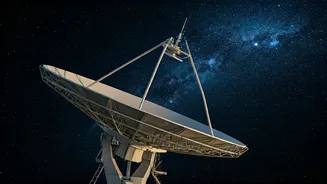Data's Ascendancy Predicted
The satellite industry is undergoing a substantial metamorphosis, and it's projected that by 2034, data services will surge in importance. This prediction
comes amid a changing landscape in how people consume content and utilize technology. The rise of data-intensive applications, such as high-speed internet, remote sensing, and the Internet of Things (IoT), fuels this growth. Satellites play a pivotal role in enabling these technologies, offering global connectivity and data collection capabilities. As more industries and individuals rely on these services, the revenue generated from data transmission and analysis is expected to experience significant expansion, shaping the future of space-based businesses.
Video's Potential Diminishment
Conversely, the sector of video services faces a potential contraction, marking a considerable divergence from past trends. Over-the-top (OTT) streaming platforms and terrestrial broadband networks are increasingly challenging traditional satellite TV providers. Consumers are progressively favoring on-demand content and diverse viewing options offered by internet-based services. This shift in viewing habits has profound effects on the demand for direct-to-home satellite television. Furthermore, the high costs associated with video content distribution via satellites, coupled with the rising availability of alternative delivery methods, could contribute to a decline in video service revenues, necessitating strategic adjustments by industry players.
Technological Drivers of Change
Technological breakthroughs are a key factor in these shifts. The rapid development of small satellites, also known as SmallSats, has brought down launch costs and increased the flexibility of satellite deployments. These satellites are particularly well-suited for data services, as they can be launched in constellations to provide comprehensive global coverage. Innovation in satellite communication technologies, such as improved data transmission rates and enhanced bandwidth capabilities, is also essential. Advances in data processing and analytics allow satellites to collect and interpret information more efficiently, making data services even more valuable. These technological advances contribute to both the expansion of data services and the challenges faced by video service providers.
Market Dynamics at Play
Various market forces are contributing to the evolving dynamics in the satellite industry. Competition is intensifying, with both established players and new entrants vying for market share. The increasing demand for data services is attracting investment and innovation, fostering a competitive environment where companies strive to offer superior services and cost-effective solutions. Conversely, the video market sees consolidation, as traditional providers grapple with declining subscriber numbers. Mergers and acquisitions are becoming more common as companies seek to streamline operations and adapt to the changing market landscape. Regulatory policies and government initiatives also play a significant role, affecting the allocation of radio frequencies and the overall investment climate.
Strategic Business Adaptations
Companies are strategizing to adapt to the changing market landscape, where diversification is crucial. Satellite operators are expanding their focus on data services by investing in technologies and infrastructure that facilitate data collection, analysis, and distribution. Some companies are also exploring partnerships and collaborations to strengthen their market presence and expand service offerings. Others are adjusting their business models by offering bundled services and focusing on niche markets where satellite technology provides a competitive advantage. The ability to adapt to new business opportunities and embrace innovative strategies will be pivotal for companies wanting to stay successful in the industry.
Future Outlook and Trends
Looking ahead, the satellite industry will likely see continued innovation and transformation. Data services are expected to remain a primary driver of growth, propelled by the expanding utilization of space-based solutions across various sectors. The integration of artificial intelligence (AI) and machine learning (ML) will likely enhance data processing capabilities, leading to more efficient satellite operations and better data insights. The rise of the space economy, driven by private investment and entrepreneurial activities, will further accelerate industry growth. Sustainability and environmental considerations will also become increasingly significant, with a greater focus on managing space debris and developing environmentally friendly practices to ensure long-term viability and growth.














